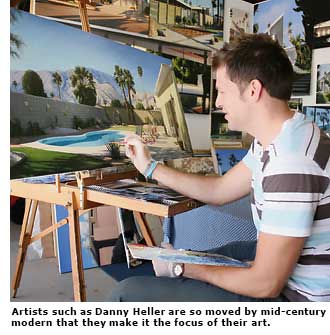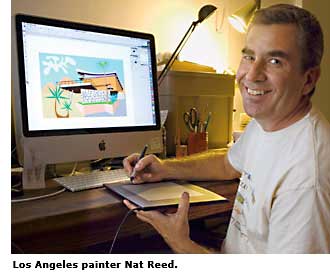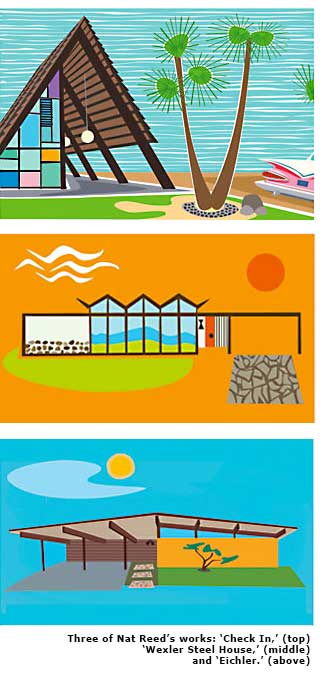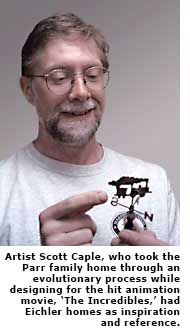Art Imitates Life: Artists Inspired by Modern Architecture
 Our homes are often seen as the backdrop upon which we enrich our lives and embellish our style. Even for devotees of Eichler, Streng, Cliff May, Palmer & Krisel, and other California mid-century modern homes, the house structure is, essentially, their canvas.
Our homes are often seen as the backdrop upon which we enrich our lives and embellish our style. Even for devotees of Eichler, Streng, Cliff May, Palmer & Krisel, and other California mid-century modern homes, the house structure is, essentially, their canvas.
It is a stylized canvas, for sure, mounted in a distinct, angular, perhaps futuristic frame. But it is still a canvas. The home provides context for the business of living, but it is background—a surrounding.
For some emerging artists, that particular mid-century modern canvas has itself become the focus. Because of its unique combination of neutrality and singularity of design, the mid-century modern look plays a dual role in the aesthetic of Americana: It symbolizes nostalgia and family security, as well as a sense of rebellion—a departure from the traditional way we choose to relate to our surroundings.
For some artists, that duality provides rich fodder for paintings that, in different ways, explore what it means to grow up in suburban America, and how our surroundings shape our attitudes.

While young artists in their 20s such as Danny Heller of Chatsworth and New Yorker Megan Berk embrace the homes as symbols of suburban life, to be celebrated but also criticized, 58-year-old Los Angeles painter Nat Reed (whose grandfather, Eli Hedley, incidentally helped introduce America to Tiki design) sees a revolutionary notion within the homes' design.
All of these artists, however, share a passion for modern architecture—both as symbols of Americana and as aesthetic masterpieces themselves—that drives them to render the homes in their work.
"I'd say, just on the face of them, these homes were a pretty radical departure from traditional styles," Reed says. "Even though people came to cast dispersions on them as tract homes, they were still this sort of new thing that people wanted to change and wanted to go into the modern age...As people have revisited them, I think the homes have really been sort of a badge of being different."
Reed lovingly acknowledges a certain 'kitsch' value of the homes, and makes reference to that in his cartoon-y illustrations. "In general, I just am really attracted to this sort of almost naïve, goofy sense of optimism."

Reed's work takes the Space Age, 'Googie' look of many mid-century designs to an almost farcical conclusion, drawing out the uniqueness of buildings that many may pass on the freeway without a second glance.
That sense of fine art hidden in plain sight also influenced Canadian Scott Caple, who designed the background for Pixar's 2004 animated movie hit 'The Incredibles.' He chose to interpret mid-century modern architecture's role in American life in much the same way as when he created the super-family's home.
Caple capitalized on the style's unique strength as a symbol of suburban America, and its easy reference to Space Age heroes such as Johnny Quest, from 1960s TV animation. But he also chose it because it is simple and unobtrusive. Flat panels and straight lines allow the viewer to focus on the family, while still providing a quiet subtext. The homes are instantly recognizable as suburban tract homes, a notion that carries with it a sense of conformity at odds with their radical design.
"In the movie, one of the themes is that [the Incredibles] have become nobodies. So they put them in this environment where everything is the same. Of course the house they have is the same as everyone else's house," Caple says.
In creating the Incredibles' home, Caple and his team visited Eichler developments in Marin County and Oakland, as well as in Southern California. He says the final product depicted in the movie comes closest to Eichlers he saw in San Rafael's Lucas Valley.
Caple says he decided to use an Eichler-inspired design precisely because it is over-stylized and unique, even while being ordinary. "A lot of those designs, the homes, the cars, they look better in the concept art than they do in real life. You draw an Eichler home and they look great, but then in real life they have telephone poles sticking up beside them," he says.
"For me, one of the exciting things about being able to come up with these designs was that, it was something I'd been looking at all my life. As a kid, flipping through magazines around the house. It instills itself in your mind."





